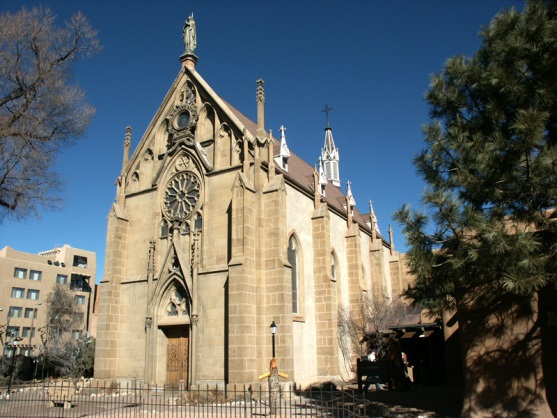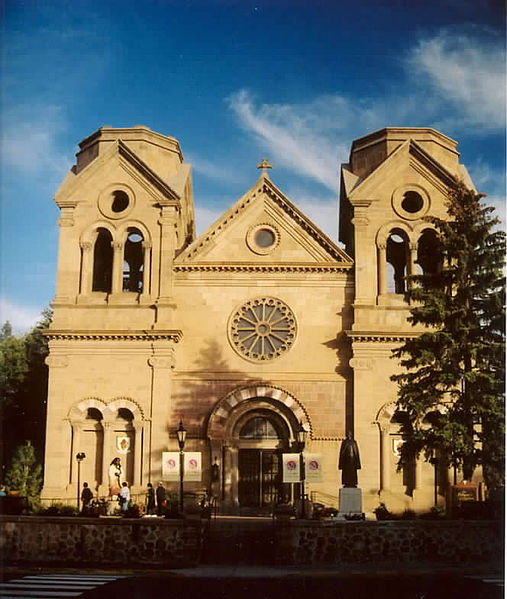Churches and Saints in Santa Fe
/Has architecture ever snuck up on you? Have you ever been inspired by a manmade structure? Or have you ever walked into a space and felt like you’d left one world and entered another reality? That’s what medieval builders of cathedrals had in mind, to move people into God’s Kingdom. Cyndi and I were in Santa Fe a couple of weeks ago, and while she attended her workshop training I decided to give architecture a shot at me. Counting on the formula: ?PA + ?PL = ?PP (or, Change of Pace + Change of Place = Change of Perspective) I spent some time inside the Loretto Chapel and the Cathedral Basilica of St. Francis, both in downtown Santa Fe. My plan was to camp out on one of the pews for an hour and read from my Daily Bible, write in my journal, ask God to speak to me, and see what happened. Some of my best spiritual encounters have happened that way, on spec.
 My first visit was to the Loretto Chapel. It is now a private museum, but it used to be the chapel for a Catholic girl’s school run by the Sisters of Loretto. It was completed in 1878.
My first visit was to the Loretto Chapel. It is now a private museum, but it used to be the chapel for a Catholic girl’s school run by the Sisters of Loretto. It was completed in 1878.
One of the things I like most about Catholic churches is they aren’t afraid to look like a church. They put it right up front, treating visitors like grownups. Even though the Loretto Chapel is no longer a church it looked very churchy. Very Catholic churchy, with dominant altar, depictions of the Stations of the Cross, a prominent crucifix, statues of various saints, and, of course, stained glass.
I like stained glass windows. I think light coming through stained glass settles worshipers, changes their heart rate, and creates expectation for transcendence. That is a quality never achieved in modern black-box worship centers.
We have stained glass windows in my home church, which is Baptist. I’m glad we have those windows, even though one image looks more like Optimus Prime than like a heavenly angel, and another reminds me of the angel of death.
However, it isn’t windows or statues that make a place holy, but rather our own anticipation. That’s why we may feel more comfortable in the type of worship space we grew up in. And when we come to a place expecting to meet God, whether in a cathedral or church or high mountain meadow, our anticipation opens our ears and eyes and heart to the voice and presence of God that we might otherwise miss because we are too busy and distracted.
My second Santa Fe church visit was to the Cathedral Basilica of St. Francis. It is a live-action Catholic church, so I had to tim e my visit between daily celebrations of mass.
e my visit between daily celebrations of mass.
What drew me specifically into this church was a biography I’ve been reading about St. Francis, Reluctant Saint, by Donald Spoto. When I walked past this giant church on Sunday morning during my downtown walkabout, I knew I had to come inside and absorb a little more of St. Francis.
I’ll admit, I grew up with serious misgivings about the Catholic veneration of saints. For one thing, I was taught that all Christians were saints because God made us saints, and not because the church tapped us on the shoulder. At best, the focus on saints seemed to be an unhelpful tangent from worshiping God himself.
And to me, St. Francis of Assisi seemed the most strange because all the statues of him I saw showed birds on his hand or shoulder or head. I didn’t understand or appreciate the connection between following God and birds.
Unfortunately, my attitude toward Catholic saints meant I never paid attention to the actual people behind the statues, people who did extraordinary things, people who lived the way I want to live my own life, people who changed their world. Reading about St. Francis may be my beginning of a new understanding of these godly men and women. It’s possible I overreacted through the years to all those statues and paintings. I should’ve looked deeper.
Not only that, after reading about St. Francis’ life, I’m starting to understand his birds. What I thought was a frivolous distraction actually represented his simple and pure pursuit of the holiness of God. It occurred to me that maybe I spent too many years laughing at the wrong things. I complicated my own spirituality so much I overlooked the power of the simple.
Sitting in one of the pews I read this from my Daily Bible, Isaiah 33, “Your eyes will see Jerusalem, a peaceful abode, a tent who will not be moved; its stakes will never be pulled up, nor any of its ropes broken.”
My takeaway from the two Santa Fe church visits wasn’t so much about the details of architectural design, as I’d expected, but more about the  permanence of the structure. Neither of my two churches were very old. There are churches in Europe nearly 1,700 years old that are still being used for worship. Still, when the Loretto Chapel was build, when the Sisters of Loretto raised money to build this, they had in mind something that would last a long time. A building that could survive the high desert climate, and handle the crush of generations of worshipers.
permanence of the structure. Neither of my two churches were very old. There are churches in Europe nearly 1,700 years old that are still being used for worship. Still, when the Loretto Chapel was build, when the Sisters of Loretto raised money to build this, they had in mind something that would last a long time. A building that could survive the high desert climate, and handle the crush of generations of worshipers.
I want my life to be like that. I want the effect of my life to live on; just like the Sisters of Loretto wanted to build a holy structure that would bless people long after the Sisters had died or moved on. I want to be a tent that will not be moved, whose stakes will never be pulled up, nor any of its ropes broken.
One more thing: at the visitor center of the Cathedral Basilica of St. Francis, I bought a small carved wooden statue of St. Francis to remember my visit. He looks very pious, and he has a bird on his shoulder and his hand. Maybe the stunning architecture allowed St. Francis to sneak up on me.
“I run in the path of Your commands, for You have set my heart free.” Psalm 119:32
Find me at http://berrysimpson.com and learn more about my books. Or find me at http://twitter.com/berrysimpson and at http://www.facebook.com/BerrySimpsonAuthor






